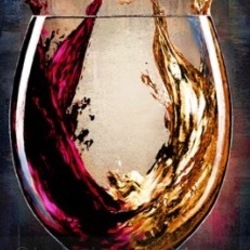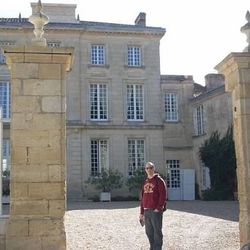Engine House 25 Wines
Primo Estate
Joseph Moda McLaren Vale Cabernet Sauvignon Merlot 1995
25 years and holding very strong. Amarone style and kicking alcohol for its day. Still rich and balanced. Dried fruit, earth and oily engine aromas. Great tannins from the Cab. Length, depth and structure is fantastic. Scary how much age this still has. — 5 years ago
Hartford Court
Russian River Valley Chardonnay 2016
Vinous nailed this in terms of description and rating. At $25, this is a low rent proposition. For their entry-level chard, this is very impressive. The shorthand that defines this wine is burgundy. This has become our house white. — 7 years ago

Château Duhart Milon
Pauillac Cabernet Sauvignon - Merlot Blend 2006
The 06 vintage was more highly praised by the Bordelais than it delivered. That’s not to say, some producers didn’t deliver.
This 06 is not at its peak...still needs a few years. Will it be a wine that blows you away? Not likely but, it will deliver nice fruit, earth & balance. Especially, with a Ribeye.
The nose shows; ripe; blackberries, dark cherries, black raspberries, baked strawberries, dry cranberries & some black plum. Saddle-wood, limestone minerals, dry stones, cinnamon, soft spice, light vanilla, black rich earth, touch of black licorice and red & dark fresh florals.
The body is round and a little lean but puts on weight with food and decanting. The structure, length & tension are falling into place. The fruits are ripe and expressive. Blackberries, dark cherries, black raspberries, baked strawberries, haunting blue fruits, dry cranberries & some black plum. Saddle-wood, touch herbaceous, mint, limestone minerals, dry clay, dry stones, cinnamon, soft spice, cola, light vanilla, black rich earth, touch of black licorice and red & dark fresh florals. The acidity is round and beautiful. The finish is on the leaner side but, well balanced and lasts a full minute. 9.1 without the Ribeye, 9.2 with it.
Photos of, Duhart Milon, Cabernet ready to to be pressed, wine making facilities and their barrel room.
Producer history and notes...the Rothschild family is divided into two sects for lack of a better word. There are the ones that own Mouton Rothschild and Cleric Milon etc. and the other owns Lafite and Duhart. The two sides of the families don’t necessarily get along. However, they are two of the oldest/wealthiest families in recorded history.
Duhart Milon was originally known only as Chateau Milon. At one time the estate was the second wine of Chateau Lafite.
The story about how this came to be is interesting. The owner of Lafite at that time was the Marquis Nicolas-Alexandre de Segur. King Louis XV called him “The Wine Prince” because of his extensive vineyard holdings in Bordeaux. The Milon vineyards were well regarded but, not as good as Lafite, which is how the wine came to be thought of as the second wine for Lafite.
In 1815, the property was considered by some people as a fourth growth Bordeaux wine in the making. In those days, the wine was sold under the name of Chateau Mandavy-Milon. Between 1830 and 1840, the Casteja family inherited the estate.
The label of Duhart Milon, according to family tradition came about from an old legend written about one of their ancestors, Sir Duhart. Sir Duhart, was rumored to have been a pirate for Louis XV. He retired in Pauillac. The “Pirate’s House” on the Pauillac port existed up to the 1950’s. That original building inspired the label for the Duhart-Milon wines.
The Casteja family remained in possession of Duhart Milon until the first part of the 20th century. At the time, Chateau Duhart Milon was one of larger Pauillac estates with around 50 hectares of vines.
In 1937, the result of successive inheritances led to the sale of Duhart Milon. The Left Bank property went through five different owners in just 25 years. As well, the vineyards were split up and with the frost of 1956, the quality of Duhart Milon continued declining until the Rothschild family purchased the property in 1962.
At that time of the sale, Chateau Duhart Milon included 110 hectares of land, of which only 17 hectares were planted with vines. The entire vineyard was in desperate need of replanting. Major renovations were urgently needed in the vineyards, which demanded work on the drainage and replanting.
The size of their vineyards were also increased with the purchase of other parcels adding to the size of their Medoc holdings. New cellars needed to be built as well.
Chateau Duhart Milon remains one of the few 1855 Classified Growth estates without an actual Chateau. At Duhart, all you will find are the cellars, vatting rooms and barrel storages.
During the period of 1970 to 2000, the vineyards nearly doubled in size! Additionally, they constructed new cellars, renovated and modernized their wine making facilities as well in 2003. By 2008, the wine of Duhart Milon increased in quality, stature and price.
Much of the price increase had to do with the association with Chateau Lafite Rothschild, which had by that time, become the most in-demand, collectible wine in China. By the time the 2015 vintage was offered, prices had dropped to a more affordable price level due to changes in Chinese laws regarding client gifts/bribes.
The 152 hectare vineyard of Chateau Duhart Milon includes; 76 hectares of vines planted to 67% Cabernet Sauvignon and 33% Merlot. This makes Chateau Duhart Milon one of the few 1855 Classified Growths with only two grape varieties planted in their vineyards.
The average age of the vines are 30 years old. The vineyard is planted to a vine density of 7,500 vines per hectare.
Duhart Milon vineyards are located in northern Pauillac, on the western side of Chateau Lafite Rothschild, on the Milon hillside, which is not far from the Carruades plateau...now Lafite’s second wine. This places the vineyard quite close to Chateau Mouton Rothschild and Chateau Clerc Milon. However, because of micro climates, this is a slightly cooler terroir, due to its northern exposure.
The naturally cooler soils provides more freshness to the wine, and allows for later picking. The terroir of Chateau Duhart Milon is a combination of gravel, sand and limestone soils. The Duhart Milon vineyards are unique in Pauillac, as the vines are for the most part, located in 1 single, large parcel.
The vinification of Chateau Duhart Milon takes place in temperature controlled stainless vats. Malolactic fermentation takes place in vat. Chateau Duhart Milon is then aged in an average of 50% new French oak barrels for 14 to 16 months, depending on the vintage.
There is a second wine, Moulin de Duhart, that was created in 1986. There is also a third wine produced by the estate, Baron de Milon. — 7 years ago


RVW Oregon House
Soleil Taken From Granite Renaissance Vineyard Cabernet Sauvignon 1995
Just what you want from an aged Northern California Cabernet. The aroma is a delicate perfume of perfectly grown, perfectly made into wine with no aim at overachieving, total purity. All the tannin has completely softened and the aroma of graceful aging is present. The granite can be felt in the mouth and dense rough texture that has been worked almost smooth over the last 25 years. The terroir signature is not super loud in this, but I’ll take the overt and delicate pleasures that this offered and forget about that. Good to the last drop. Lots of sediment in this which I really don’t mind, but good to note for anybody digging into a bottle. Extra point for being completely natural and achieving such a clean and pure pleasurable result at 25 years of age and having only arrived in the mail one week ago. Remarkable. — 5 years ago
Cline Cellars
Ancient Vines Contra Costa County Zinfandel 2017
Goes well with spiced foods like curry. Sweeter side. Had it at Jiyi’s & Sam’s house for Christmas steak dinner. 12/25/19 — 6 years ago
Lujon Wine Cellars
Walla Walla Valley Cabernet Sauvignon 2015
I had pretty modest expectations and this one frankly shocked me at how good it turned out to be. Right off the bat, luscious blackberry, smooth tannins and surprising complexity and length for a $25 Cab, and for which I paid less. This could easily become a house wine. Lucy approves! — 6 years ago
Macallan Distillery
25 Year Old Sherry Oak Cask Single Malt Scotch
A Great night to say the least:
Magnum of Gargiulo money ranch road,
2000 Bryant, 25 year Macalllan. Totally forgot to post this pick from a few weeks back!
The Bryant drank as good as any French Bordeaux that I’ve ever had. The money ranch toad was mediocre in comparison and the 25 year Macallan was 2nd only to the amazing company we had in our house that night!!
Great times to say the least!
— 7 years ago



La Pitchoune
Van Der Kamp Pinot Noir 2014
Second stop in Sonoma with Andrew Berge of Spell Estate, La Pitchoune and Tiny House to name a few. Last red from La Pitchoune is their Black Label VDK from the Van der Kamp Vineyard on Sonoma Mountain. Aged for 12 months in 25% new French oak barrels and then aged for an additional 11 months in 50% new French oak. That is a total of 23 months in French oak and only 48 cases produced.
Deep ruby red with purple core and garnet edges. Rounded and lush nose with dark cherries, raspberries and a little bit of cola. Well balanced and integrated acidity (6.5/10) with a medium plus body. Light spices on the palate like cinnamon and nutmeg followed up by rich raspberries and a bit of gravel in the long finish. Drink till 2030. $$$ — 7 years ago

La Pitchoune
English Hill Vineyard Pinot Noir 2014
Second stop in Sonoma with Andrew Berge of Spell Estate, La Pitchoune and Tiny House to name a few. Next red from La Pitchoune is their English Hill Vineyard. Aged for 11 months in 25% new French oak barrels and only 98 cases produced.
Brick edges and a medium ruby core. Rich nose with purple flowers, dark red berries, blood orange rind and cherries. Medium plus acidity (7.5/10) and medium bodied. A bit young on the palate and green with a freshly broken twig underneath notes of strawberries, under ripe cherries, white pepper and earth. Long finish. Still a baby that needs a little bit of time to open up nicely. Drink till 2028. $$ (90+) — 7 years ago
Louis Roederer
Brut Premier Champagne Blend
25 November 2017. Bryant & Cooper Steak House, Roslyn, NY. — 8 years ago
Château Canon
Saint-Émilion Red Bordeaux Blend 1986
We were suppose to be in Napa this weekend. Sadly, no one should be in Napa/Sonoma except Firefighters and first responders. However in lieu of; the Sodhani party, appointments at Beau Vinge, Mark Herold & a steak at Cole’s Chop House, what the next best thing? #STEAKANDCLARETNIGHT at home in the backyard. This 86 was amazing with my ribeye. The kind of pleasure that causes great pause and rolls the eyes a bit. On the nose; menthol, eucalyptus, dry herbs, soft ripe blackberries, dark cherries, strawberries, baked plum, perfectly stated baking spices, stones, soft unstated spice, clay, rich dark earth, touch of black cherry cola and fresh & dark florals. The palate is heaven as it coats. The body medium full, layered and the tannins are nicely resolved but not completely...still a fair amount of life in this bottle. I’d say it’s still around it’s peak. The fruits are ripe and still fresh. Blackberries, baked plum, dark cherries, strawberries, dry cranberries, hues of blueberries, black cherry cola, sweet darker spice, vanilla, clove, nutmeg, cinnamon, dark rich earth, dry stones, tobacco, suede leather, dry clay, menthol, eucalyptus, touch of dry herbs, fresh & dry dark flowers, beautiful, round acidity, perfect 12.5% alcohol and a long, even, elegantly balanced with beautiful structure, tension & length that’s lasts two minutes. It’s in a really excellent spot. 9.6 with the ribeye and 9.4 on it’s own. Photos of; an aerial shot of Chateau Canon, owners Alain and Gerard Wertheimer who made their first big money on Chanel, own Rauzan-Segla and are worth just under a paltry 10 billion, their barrel room and their Saint-Emilion vineyard. Producer notes and history...Chateau Canon is a premier cru with a history of fine vintages. This Saint-Emilion property has long been recognised as one of the best in the appellation. It is believed that Canon was named after Jacques Kanon, the naval officer who bought estate in 1760. He built the château here and surrounded it with plantings solely of vines...a rare agricultural practice at the time. However, he then sold the estate to a Bordeaux négociant just ten years later. In 1919 it was purchased by the Fournier family, who owned the property until 1996. When they sold it to the Wertheimer family, owners of Chanel and of Rauzan-Ségla in Margaux it unfortunately had some serious problems. The cellars were contaminated with TCA, the chemical compound which causes cork taint. Many of the vines were infected by viruses and in need of being replaced. As well, part of the vineyard above the quarried cellars had subsided. Fortunately the Wertheimers had the money to fix these issues and a manager, John Kolasa with the skills. The first decade of the 21st century saw Canon begin to regain its reputation once John Kolasa retired and Nicolas Audebert at Rauzan-Ségla took over. The substantial estate covers 22 hectares on Saint-Emilion’s famous limestone plateau close to the town. The vines have an average age of 25 years and are generally planted with a southerly or south-westerly exposure. 75% of the vines are Merlot and 25% Cabernet Franc. After the grapes are hand-picked, they are fermented in traditional cone-shaped vats, before spending 18 months ageing in oak barrels, 50% new and 50% used. — 8 years ago


Kirkland Signature
Riserva Chianti Classico Sangiovese 2016
Drank 5/25/20. Very nice with lasagne.
Nose of earth, black cherry, and cranberry opens to flavors of black cherry, leather, and earth. Very nice balance. Medium finish dominated by black cherry , earth and medium plus tannins. Give this one a 30 + minute decant and a bit of a chill.
3/21/8/4/3 +50 =89 pts.
Unbelievable value Would highly recommend as a "house italian". — 5 years ago
Iron Horse Vineyards
Wedding Cuvée Sparkling Blend 2013
This wine hit 18 on top 100 list in 2017. Best known for Sparkling Wines, served at White House since 1985. Pale salmon color, a blend of 75% Pinot Noir and 25% Chardonnay & aged 3 years prior to release, showing aromas of red fruit with citrus and biscuit notes. On the palate apple, strawberry and cherry flavors with orange zest, earthy yeasty spice and tiny bubbles. The wine is well balanced, good acidity, some yeast and minerality on the long finish. — 5 years ago
Robert Biale Vineyards
Like Father Like Son Napa Valley Syrah Blend 2010
50/50 Syrah & Petite Syrah blend.
Color, it's so purple and dark! Reminds me of Heitz 'Ink Grade' Port.
Nose has ripe, crushed blueberry and blackberry, light creamy oak, cut plum, prune and just a touch of baking spice.
Palate has blueberry juice with acidity subdued by mellow oak, crushed blackberry, black currant, faint cedar plank, moist-tanned leather and light black pepper.
After ~3hr decant we still had trailing heat from the alcohol (15.2% ABV), but it disapated in another hour or so. A great paring with some local Delmonico steaks on the grill, cooked to a beautiful 130°F.
When good protein is served at our house eight paws will be in waiting on our dining table. My wife and I only take two of our six chairs, others will have one hungry 🐈 each. We all enjoyed a great meal tonight, some albeit some with much smaller portions.
This is the youngest version of this bottle in our cellar, the 2010 can easily reach 2023-25. — 6 years ago

Raventos i Blanc
L'hereu Conca del Riu Anoia Blanc de Blancs Xarello Blend 2015
A pale salmon orange, the nose has mostly delicate floral aromas with slight interwoven yeasty undertones and a little bit of green strawberry and orange blossom. Very fine, extremely dry, mineral driven and chalky. Has flavors of subtle white pepper and bitter citrus that come through after the wine warms a little. This is a very delicate aperitif friendly wine with elegance of an established champagne house and for under $25. — 7 years ago

La Pitchoune
Van der Kamp Vineyard Pinot Noir 2014
Second stop in Sonoma with Andrew Berge of Spell Estate, La Pitchoune and Tiny House to name a few. Next red from La Pitchoune is their Van der Kamp Vineyard. Aged for 11 months in 25% new French oak barrels and only 98 cases produced.
Brick red edges with a medium ruby core. More red fruit on the nose than the VDK Pinot Noir with notes of violets, lilac and twigs. Medium plus acidity (7/10) and a medium plus body. Layered palate with raspberries, some cassis, spices, especially cinnamon and crushed gravel. Lengthy finish with acidity lingering. Drink till 2028. $$ — 7 years ago
La Pitchoune
Holder Vineyard Russian River Valley Pinot Noir 2014
Second stop in Sonoma with Andrew Berge of Spell Estate, La Pitchoune and Tiny House to name a few. Next red from La Pitchoune is their Holder Vineyard Pinot Noir. Aged for 11 months in 25% new French oak barrels and only 98 cases produced.
Medium ruby red with brick edges. Complex nose with elegant layers of spices, sweet tobacco, leather, black raspberries and purple flowers. Medium plus acidity (7/10) and medium bodied. Earthy attack on the palate with some strawberries, rose water, raspberries and violets. Dry and long finish. Drink till 2028. $$$ — 7 years ago
Bodegas Volver
Tarima Monastrell
12/25-17 - Sisters house in Z-town with the fam. Really good balanced Monastrell, easy drinking and nice finish. — 8 years ago
Canard-Duchêne
Authentic Rosé Brut Champagne Blend
45% Pinot Noir / 30% Chardonnay / 25% Pinot Meunier
On the nose, strawberry shortcake, raspberry and citrus peels.
On the palate, red raspberry/currant and minerals. Dry.
At $40 I have not seen a better brut rosé bottle at this price point. This is the stuff I want to flow out of my faucet when I turn the handle! We can never have enough of this Champagne! Seek and you will be rewarded.
Producer Note:
Canard-Duchêne is unique in its origins, history and style. The Champagne house has been located in Ludes, in the Montagne de Reims National Park, since 1868, and is one of the original Grandes Marques. Its founders, Victor Canard and Leonie Duchêne, both well-known characters in Champagne, were granted the right by the Russian Imperial Family to adopt its coat of arms as the family emblem. The crowned two-headed eagle has thus appeared on every Canard-Duchêne label since the end of the 19th century. These authentic, original Champagnes combine fruit, intensity and complexity.
@David T
This is my version of your Billecart-Salmon Brut Rosé. — 8 years ago










Diana Cristina Patiño
A Brut Prestige from @champagneaspasie 🇫🇷 It is a non-vintage bottle consisting of 50% Chardonnay, 25% Pinot Meunier, and 25% Pinot Noir.
This Champagne House is located in the region of Montagne de Reims in Champagne, France. Pinot Noir is the most planted grape in this area. It is a solid Champagne! 🥂 Cheers!
#champagneday — 5 years ago